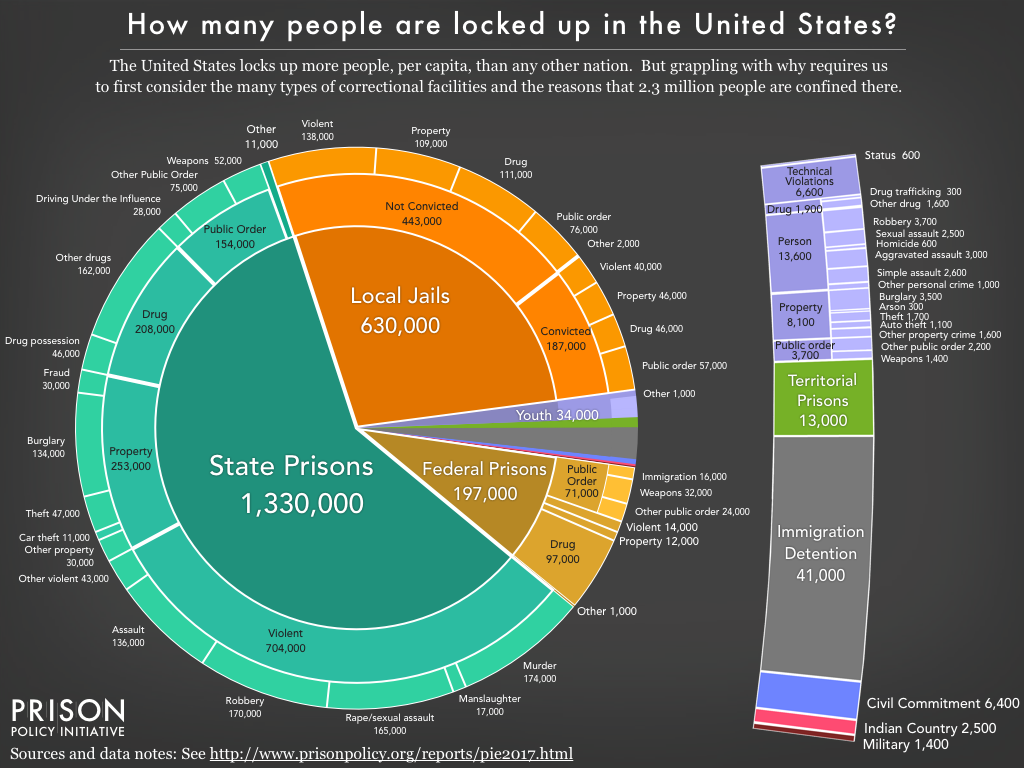New report, Mass Incarceration: The Whole Pie 2017, pieces together systems of confinement and provides 15 new infographics
With this year’s updated edition of Mass Incarceration: The Whole Pie, we once again answer the essential questions of how many people are locked up, where, and why.
March 14, 2017
Are there 1.3 million people behind bars in the U.S., or is it actually closer to 2.3 million? How important are probation and parole when we think about the scope of the criminal justice system? In 2014, the Prison Policy Initiative first aggregated data on the country’s fragmented systems of confinement. With this year’s updated edition of Mass Incarceration: The Whole Pie, we once again answer the essential questions of how many people are locked up, where, and why.
The publication of the new report, with 15 new data visuals, comes at a critical moment. The new administration has taken aim at the past decade’s advances toward criminal justice reform, and has a troubling reliance on “alternative facts” to support its agenda. The Whole Pie 2017 brings together the most current government data available to provide policymakers and the public a clear and accurate big picture view of punishment in the U.S.
The 2017 report shows that mass incarceration is not a single monolithic system. Instead, we have a federal system, 50 state systems, and thousands of local government systems. The byzantine structure of justice systems means the policymaking is equally complex and changes must be made at each level. While the White House is moving away from criminal justice reform, The Whole Pie offers the reassuring reminder that the bulk of incarceration flows directly from the policy choices made by state and local — not federal — governments.
Other surprising findings include:
- 99% of jail growth over the past 15 years was in the detention of people who are presumed innocent.
- While law enforcement continues to arrest more than 1 million people each year for drug possession, the numbers in The Whole Pie show that ending mass incarceration will require rethinking not just the war on drugs, but also our society’s response to violent crimes.
- The juvenile justice system locks up 7,200 youth whose “most serious offense” is not even a crime. 6,600 children are locked up for “technical violations” of their probation, and 600 for “status” offenses which are “behaviors that are not law violations for adults, such as running away, truancy, and incorrigibility.”
- 57,000 people are locked up for criminal or civil immigration offenses, and ICE detention numbers are growing.
The United States locks up more people than any other country, at a rate more than five times higher than most other nations. One impediment to reform is the lack of available data to guide that conversation. In The Whole Pie, the Prison Policy Initiative provides the comprehensive view of mass incarceration that society needs in order to plot a path forward.
The non-profit non-partisan Prison Policy Initiative was founded in 2001 to expose the broader harm of mass criminalization and spark advocacy campaigns to create a more just society. The organization leads the nation’s fight to keep the prison system from exerting undue influence on the political process (a.k.a. prison gerrymandering) and plays a leading role in protecting the families of incarcerated people from the predatory prison and jail telephone industry and the video visitation industry.
Mass Incarceration: The Whole Pie, an annual report released each year on Pi Day, is a part of the organization’s National Incarceration Briefing Series. Recent reports in that series include Following the Money of Mass Incarceration, which aggregates economic data to offer a big picture view of who pays for and who benefits from mass incarceration, and Detaining the Poor: How money bail perpetuates an endless cycle of poverty and jail time, finding that the ability to pay money bail is impossible for too many defendants because it represents eight months of a typical defendant’s income.
The report is available at: https://www.prisonpolicy.org/reports/pie2017.html
-30-





[…] Recently I came across the Prison Policy Initiative as a new source of information on how our judicial system actually works. PPI just released a new pie chart and other graphs, “How many people are locked up in the United States?” […]
No wonder American society has become less tolerant and simply put, meaner. The infatuation of guns and and almost reverent view of the military coupled with fear propaganda of every kind has done it’s job. Locking people up for almost any reason clearly means criminal behavior is privatized now to a point we can no longer say crime doesn’t pay. Clearly it does for a few.